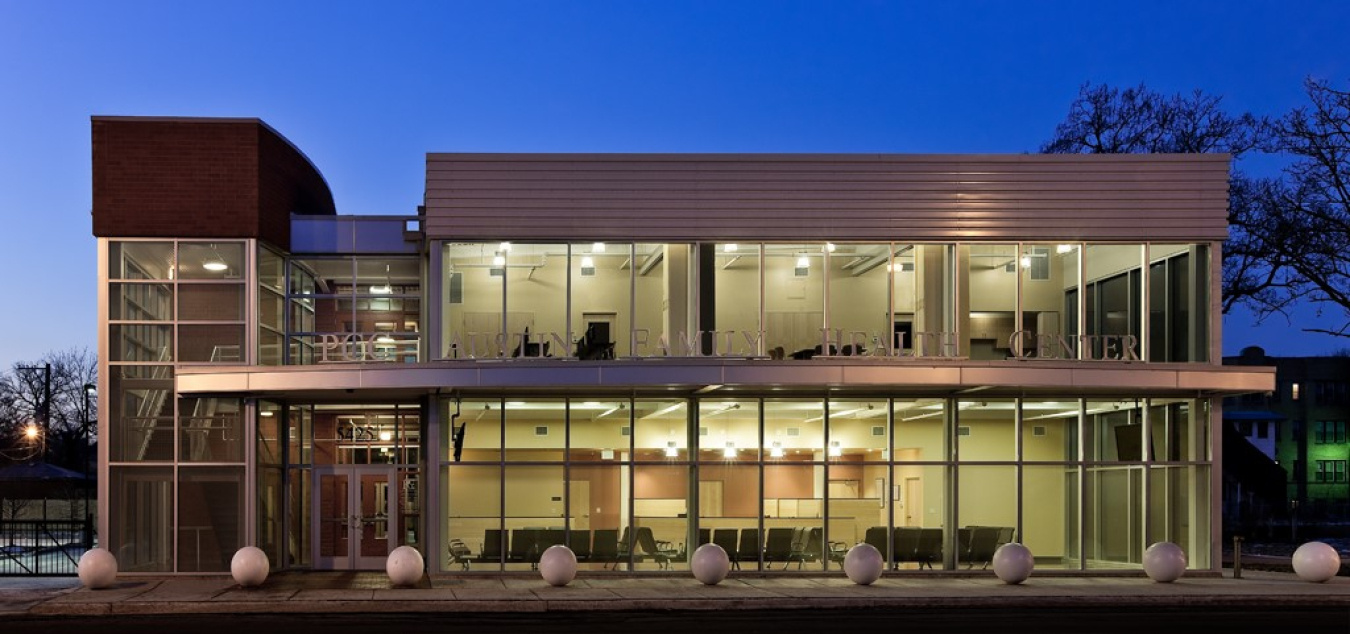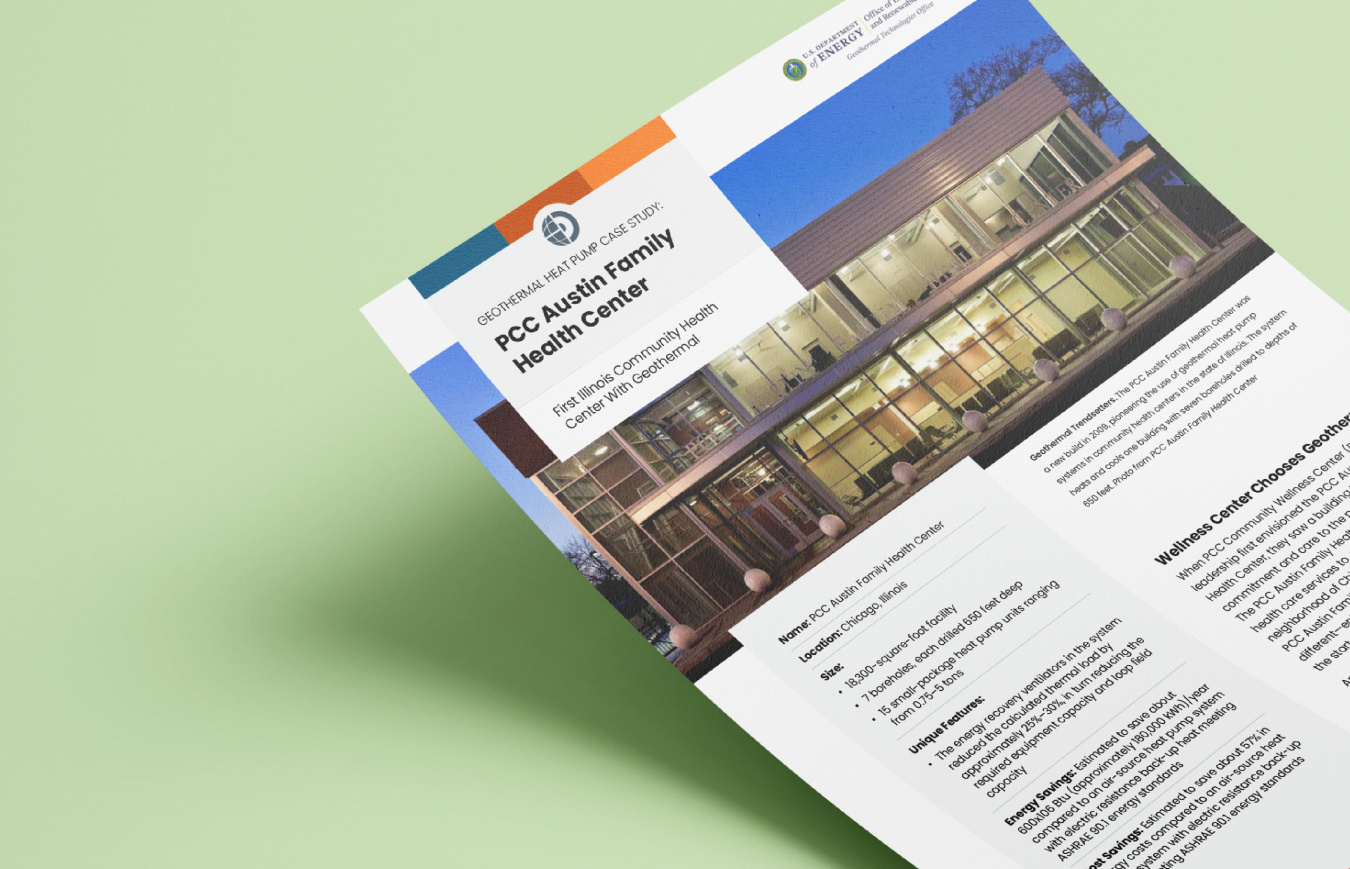
Geothermal Trendsetters. The PCC Austin Family Health Center was a new build in 2009, pioneering the use of geothermal heat pump systems in community health centers in the state of Illinois. The system heats and cools one building with five boreholes drilled to depths of 650 feet. Photo from PCC Austin Family Health Center
Fast Facts
Location: Chicago, Illinois
Size:
- 18,300-square-foot facility
- 7 boreholes, each drilled 650 feet deep
- 15 small-package heat pump units ranging from 0.75–5 tons
Unique Features:
- The energy recovery ventilators in the system reduced the calculated thermal load by approximately 25%–30%, in turn reducing the required equipment capacity and loop field capacity
Download the full case study for additional fast facts.
Wellness Center Chooses Geothermal
When PCC Community Wellness Center (PCC) leadership first envisioned the PCC Austin Family Health Center, they saw a building that showed commitment and care to the people it served. The PCC Austin Family Health Center provides health care services to people living in the Austin neighborhood of Chicago. Leadership decided PCC Austin Family Health Center would be built different—entirely heated by geothermal from the start.
An engineering consulting design firm designed the facility’s geothermal heat pump (GHP) system in 2007–2008. At the time, geothermal heat pumps were uncommon in Chicago. But the concept was promising, and the system’s innovative energy features would set the new health center apart.
A Small but Mighty System
The engineer consultants identified small-package heat pump units as the simplest and easiest-to-maintain solution for the health center building. Fifteen such units, ranging in capacity from 0.75 to 5 tons of refrigeration, were installed in the ceiling space, five for the first floor and 10 for the upper floor.
At this site, small packaged heat pump units were less expensive to install than reversible chillers serving air handling units. Because they are installed indoors, they are also easier to maintain in the notoriously cold and harsh Chicago winters. The engineers learned during construction that the ceiling space needs to be roomier than systems that might be placed outside or on a roof to accommodate maintenance workers.
The system consists of 7 boreholes that are each 650 feet deep, but this was a change from the original design of 20 boreholes, each 300 feet deep. Contractors found unanticipated underground concrete structures on the site, including an old foundation, so the drilling contractor redesigned the field using a deeper borehole length with fewer boreholes. This alternate design has now sustained 15 years of good performance with the field still operating within the expected temperatures.
The two-story, 18,300-square-foot PCC Austin Family Health Center is LEED Gold certified. The center provides medical care, dental care, and counseling. Photo from PCC Austin Family Health Center.
Energy Savings:
- Estimated to save about 600x106 Btu (approximately 180,000 kWh)/year compared to an air-source heat pump system with electric resistance back-up heat meeting ASHRAE 90.1 energy standards
Cost Savings:
- Estimated to save about 57% in energy costs compared to an air-source heat pump system with electric resistance back-up heat meeting ASHRAE 90.1 energy standards
Opportunity To Gain a Competitive Edge
The building’s geothermal heat pump system was unique when it was being developed and served as a talking point for fundraising and garnering support for the project. In fact, other health centers in the area visited the site during construction with an interest in using a similar system in their own facilities, even going so far as to hire the same contractor. The PCC Austin Family Health Center was so successful, PCC built a second facility down the street with an identical heat pump system.
“I would recommend a geothermal heat pump system to other health facilities without reservation. It’s great for funding opportunities, it’s great for publicity, and it’s great for the world.”
Patrick Thompson, Principal, Manske Dieckmann Thompson PLLC
Contacts:
For questions about this case study, contact Mark Nussbaum, Architectural Consulting Engineers, mark@ace-oakpark.com
For any website technical issues or general questions about geothermal heat pumps, contact DOE.Geothermal@ee.doe.gov.
Printable Version
Download the printable PCC Austin Family Health Center case study or visit the Geothermal Heat Pump Case Studies page to see more examples of geothermal heat pumps in action.


